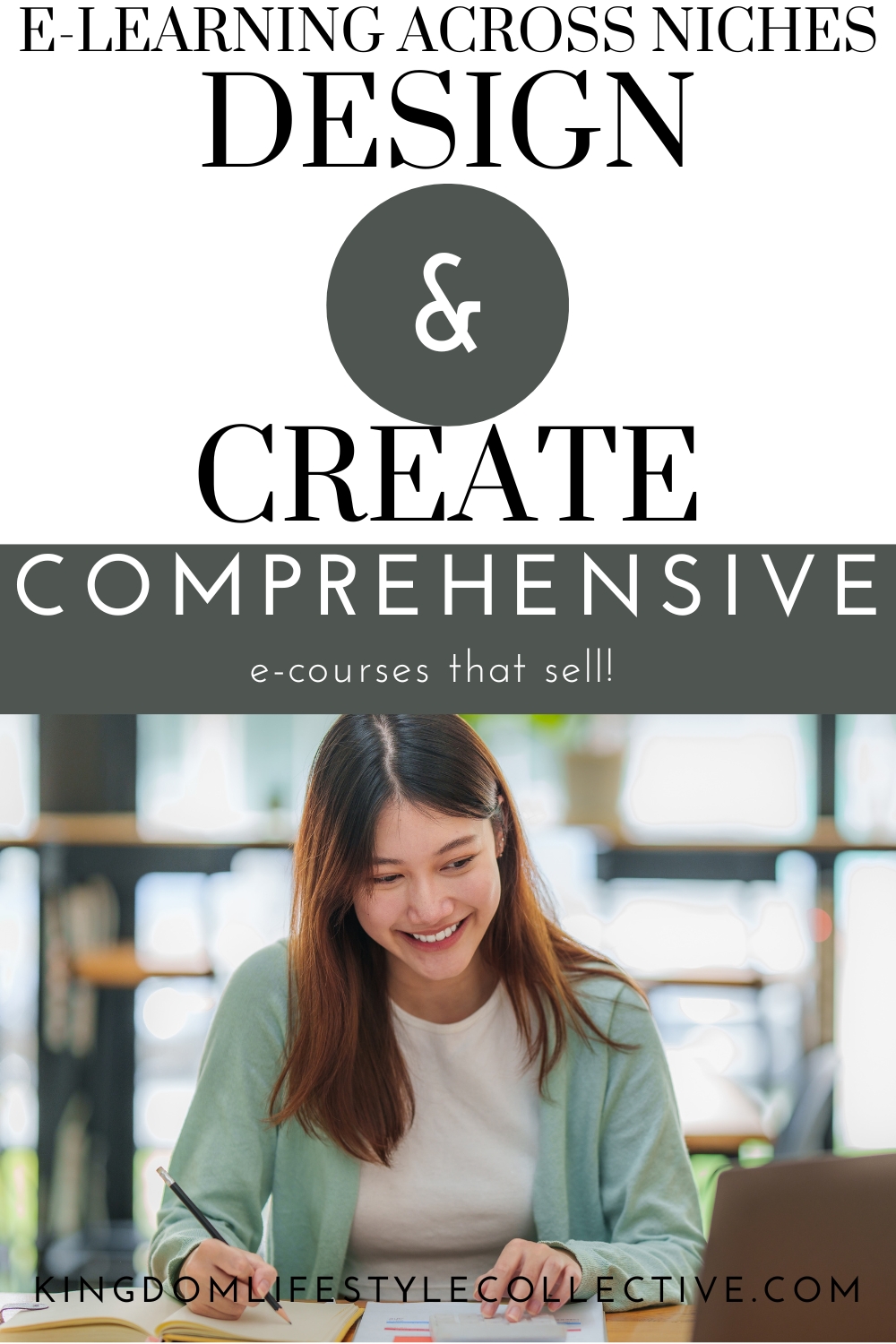The Versatility and Reach of E-Learning
E-learning is incredibly diverse, offering educational opportunities across niches. From technical skills to artistic ambitions, e-learning has increased access to education, making it accessible and affordable. E-learning has grown significantly, surpassing traditional educational boundaries and proving its immense potential across various niches.

From corporate training modules to personal development courses, e-learning platforms (my favorite being Kajabi!) offer tailored, accessible, and flexible learning solutions. However, this digital revolution in education caters to diverse learning styles and schedules, letting users learn at their own pace, anytime, anywhere and that might be it’s biggest perk. As technology advances, the potential for e-learning to grow and expand into new niches continues to unfold, promising a future where knowledge is more accessible and inclusive than ever before.
Key Elements for Any Niche
In e-course creation, certain elements stand as pillars of success across all niches. Clear learning objectives set the stage, providing both creators and learners with a roadmap of what to achieve. An organized curriculum ensures a logical progression, guiding learners through each step of their educational journey.
Quality content, filled with relevant information and practical insights, forms the core of the learning experience, engaging and enlightening students. Moreover, adding effective learner engagement strategies, such as interactive assignments and community discussions, fosters a dynamic learning environment. Together, these elements form a successful e-course, ensuring a rewarding and powerful learning experience for all participants.
Tailoring Learning Experiences
One of the strengths of e-learning is the ability to customize educational experiences to meet the specific needs of learners in various niches. This involves understanding your audience’s unique requirements and interests and designing the course content accordingly.
Designing an e-course that caters to the diverse needs of learners requires a thoughtful approach to assessment and adaptation. Start by having surveys to understand your audience’s backgrounds, learning styles, and objectives. Depending on your niche, analytics on social media and google might be enough to determine who you are helping. Incorporate a mix of multimedia content, such as videos, text, and interactive activities, to appeal to visual, auditory, and kinesthetic learners.
Offer flexible learning paths with bonus modules for those seeking deeper exploration or needing extra support. Regular feedback opportunities through quizzes, discussions, and assignments allow for ongoing learner needs assessment. By adapting content and teaching strategies based on this feedback, instructors can create a more inclusive and effective learning environment for all participants.
Creating a Healthy Course Structure
The design of your e-course plays a crucial role in its effectiveness. An organized course ensures a logical and comprehensive learning journey. Outlining an e-course effectively begins with clearly defining learning objectives, ensuring that each module aligns with these goals. Start by mapping out the key concepts and skills learners should acquire, breaking them down into smaller, logically sequenced modules.
For each module, identify the main topics, learning activities, and assessments to reinforce understanding of the learning objectives. Incorporate a variety of content formats to cater to different learning styles, including videos, readings, and interactive elements. Lastly, plan for regular checkpoints or quizzes to assess learner understanding and provide feedback. An effective outline is a blueprint, guiding course creation and learner progress toward reaching desired outcomes.
Developing your course outline is also something I recommend ethically utilizing AI to help with. You input as much information as possible and request help outlining it. Ensure each module fits the needs of multiple learning styles by adding videos, text, and learning activities.
Enhancing Learning Through Interactivity
Incorporating interactive elements like quizzes, forums, and multimedia into e-learning courses can enrich the learning experience significantly. Here we delve into the crucial role of interactivity in the educational process and offers strategies for integrating these dynamic components effectively across various course niches.
Educators can create a more immersive and effective learning environment by engaging learners through interactive quizzes, fostering community and discussion through forums, and captivating attention with interactive media. These elements facilitate deeper understanding and retention of course material and cater to different learning styles, making education more accessible and enjoyable for a diverse audience.
Leveraging Digital Tools for Effective Learning
Technology and multimedia are pivotal in shaping the e-learning landscape, offering many ways to enhance and transform the educational journey. From engaging video lectures that bring concepts to life to virtual simulations that offer hands-on experience in a digital format, the thoughtful integration of technological tools is key to crafting an immersive and impactful learning environment.
Incorporating interactive videos, utilizing virtual reality for real-world simulations, and integrating multimedia elements like podcasts and infographics make learning more engaging and cater to various learning preferences, ensuring a comprehensive and enriching educational experience for all learners.
Unique Strategies for Varied Fields
Creativity in course design is a crucial differentiator in the competitive realm of online learning. With the digital marketplace becoming increasingly saturated, employing inventive and unique approaches in your e-course design can significantly distinguish your offerings. Here you want to explore various creative strategies meticulously tailored to suit specific niches, and showcase the application of innovative methods across diverse subjects.
From integrating storytelling elements and gamification to leveraging augmented reality and interactive case studies, these creative techniques captivate learners and profoundly enhance their understanding and retention of the material. By embracing creativity, educators across niches can create compelling, memorable learning experiences that stand out.
Evolving with Learner Input
Feedback is a crucial component of the e-learning process. It helps continuously improve the course based on learner input. Sometimes, individual learners might struggle in specific areas. However, many times when you are new to creating e-courses, multiple people get “stuck” at the same point in the process. This can indicate that your communication wasn’t as effective as you hoped, and a section needs to be updated and reworked to become clearer.
Conclusion
Embracing the diversity of e-learning across niches requires understanding foundational principles, employing creative strategies, and staying informed about emerging trends. By doing so, educators and course creators can develop comprehensive and engaging e-courses that cater to various learning needs and preferences. If you want more information on starting your E-course I recommend reading the articles below and signing up for my mini-book of ethical AI prompts for bloggers and creators.
How to Design a Profitable Online Course
Profitable Online Course Niches and how to Find Them!
















